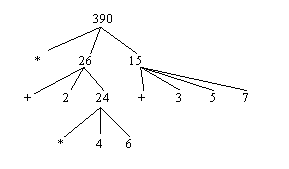- evaluate subexpressions of combination
- apply procedure to resulting arguments
- Terminals: operators or numbers
- Nodes: combinations
- the values of numerals are the numbers that they name
- the values of built-in operators ar the machine instructions sequences that carry out the corresponding operations
- the values of other names are the objects associated with the names in the environment
(* ( + 2 ( * 4 6))
- (+ 3 5 7))

(define x 3) does not apply define to two arguments, one of which is the symbol x, the other of which is 3)
- have own evaluations rules